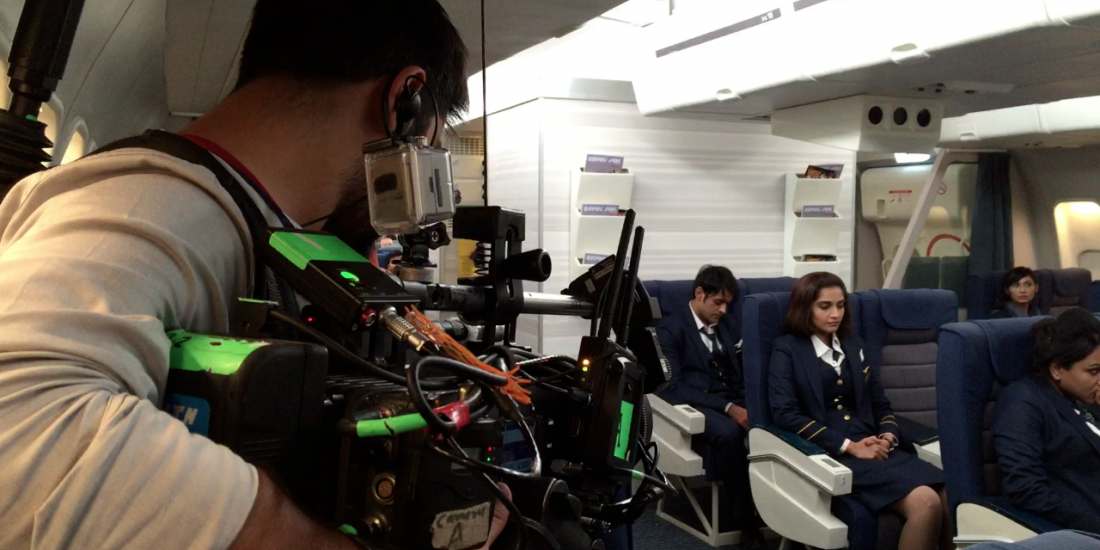I consciously wanted the camera to be an observer ~ Mitesh
If the recently released Neerja is being applauded for its honest portrayal of a brave and selfless story, it is also being appreciated for all its technical facets. One of the most important aspects being the film’s cinematography, which kept us gripped throughout the story. For Neerja‘s 26-year-old cinematographer Mitesh Mirchandani, the biggest achievement has been the fact the viewers were oblivious to the camera work and more engrossed in the story and characters. In a candid chat, Mitesh talks about the film’s shooting experience.
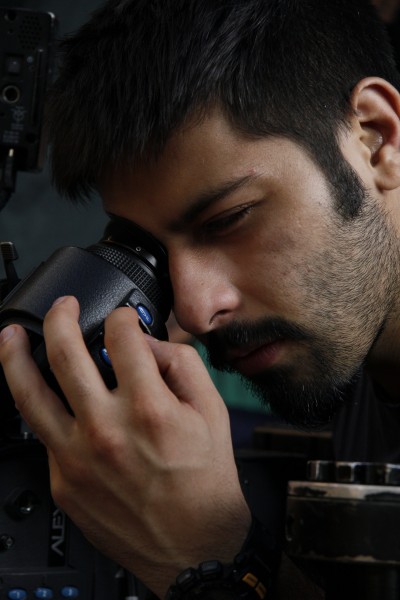
Cinematographer Mitesh Mirchandani
In the film, the beginning intercuts between Karachi and Bombay form the base of the growing tension. And the jerky camera gives us a feeling of urgency. How have you used the camera and lighting to create the desired atmosphere?
I didn’t want a drastic difference between the exterior of the party and the terrorist area. Often terrorist areas are made to look little grungy, which I didn’t want because when you look at the terrorists you obviously know who they are. The idea of intercutting between Bombay and Karachi was to grip the audience as soon as the film begins. Except Shabana ji’s speech at the end, the entire camera is handheld. We wanted to start with that energy so the camera always kept moving.
There is a sense of fear that exists from the very beginning and is prevalent in the happy moments as well. What role has the camera played in making that possible?
I like to shoot with wide lenses and close to the action so that you feel that you are within the space along with the actor. I didn’t want the camera to take too much away from the story because the story is too strong. I wanted the camera to be a backbencher and observe what is going on. By keeping it subtle, I have attempted to not do any dramatic moves. I consciously wanted the camera to be an observer.
What kind of challenges does a film bring in when you have to work in the same time and space zone?
The biggest challenge is light because when you are shooting exterior the sun keeps moving. For this film, we didn’t want to use any light or create any artificial energy and so Ram (Madhvani, Director) was kind enough to give me early morning light for four days. The initial scenes of the terrorists entering the airport have been shot at the exact same time over four or more days. We had four cameras in the plane so we had the luxury of capturing the movements together. I have also paid a lot of attention to the graph of the day. So when the plane lands in Karachi and the terrorists enter, it is the magic hour and hence the sky is blue. That is the only time when the harsh light came in. When the door opens, the outside is really bright, which is the case when people actually get out of an airplane. I have tried to overexpose the outside so that you feel the amount of light that is coming in.
READ: I DISCOVERED MY HERO THROUGH NEERJA
Were the angles and frames in the film pre-decided to evoke the right emotions?
Ram and I talked a lot about how the film should be visually treated. We wanted the film to feel very candid. So I had four camera operators and one of them wasn’t even a DOP. He is Rohan Thakur who is actually a director and loves the camera. He has a great sensibility and I got him on board because he would never frame a shot but just capture it as is. I told the same to all my camera operators. The great part is that the film doesn’t appear to have been shot by four cameras. That’s why we thought that it shouldn’t be framed in a proper way. And the actors were free to move within the frames. It was free-flowing for everyone – they could go to the washroom, the galleys were functional so they could take water and were free to do whatever they wanted. It was a completely new technique of filmmaking.
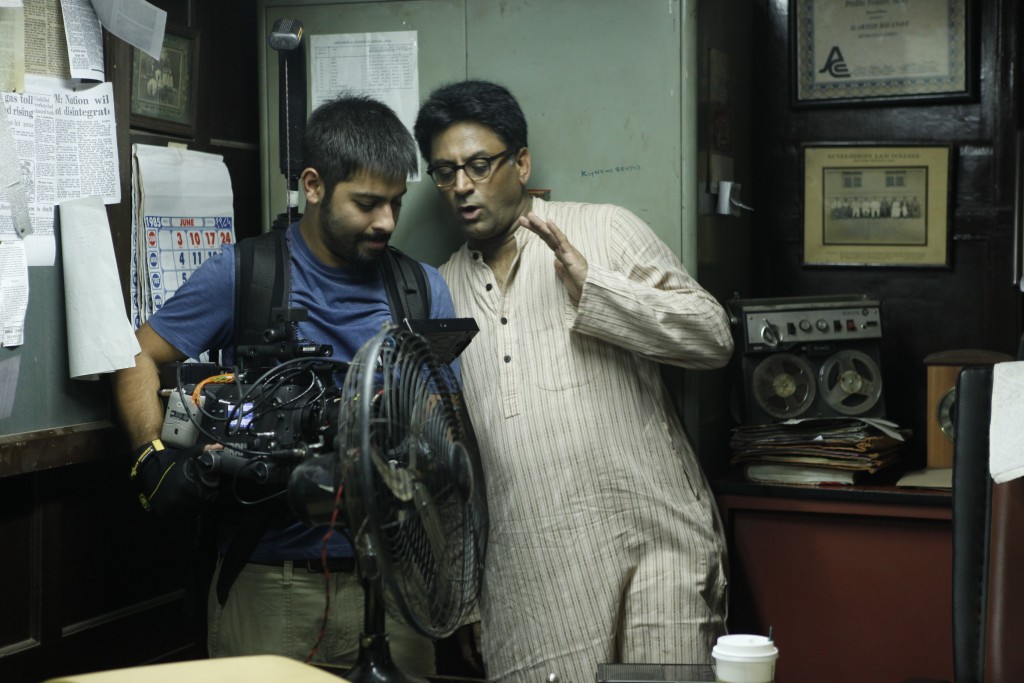
With director Ram Madhvani
But isn’t this process difficult?
Yes, it is difficult but we all were so ‘in the moment’. All the four operators were somehow present at all the right moments. It was definitely tough as I had earlier never done a 45-minute take on my shoulder.But there was so much happening that I never once felt that the take was so long.
We had a great plan and a lot of pre-production was done from the camera perspective. It wasn’t like a normal film where you have 20 people around the camera as the doors of the plane were shut. So it was just my focus puller and me and same was the case with the other three cameras. It makes work much easier. And for me the biggest achievers in this film are the focus pullers. They have done the best job because they never had any specific marks as the actors could go wherever they wanted. If you see how it has been shot, it was so unreal. Keeping things sharp when people are moving and they don’t even know where the camera is, is quite remarkable.
Did Ram Madhvani suggest this shooting approach or or was it a collaborative decision?
A lot of it came from him but we mutually discussed everything. He didn’t want to use lights or make the actors feel that they are shooting under artificial light as it would take away the emotion and the performance. At first I was a bit reluctant about the approach. I have done several commercials like this where I have kept things minimal and shoot without lights. Ram and I had done a commercial called ‘Kindle Paperwhite’ where the guy is traveling all over. Even for that, he didn’t want me to use lights. And that was when we really understood each other.
So how did you go about lighting the interior of the plane?
We didn’t want to light the film and wanted it to be very natural. I have not used any lights and even the aircraft has only the existing lights – bulbs and tubelights. I lit the plane like a normal plane is lit. I used normal tubelights and also used Kino Flos as I wasn’t getting the right exposure with the tubelights. The plane appeared very flat with the top lights. So I added some tungsten tubelights in the galley, so that one doesn’t see just blue all over. And I researched a lot to find the kinds of light that they have in the plane and just replicated it. Everything in the plane is so flat that those lights bring in a contrast that I love.
READ: WE DIDN’T HAVE THE BUDGET TO PULL OFF NEERJA
Tell us more about the research that you did for the film.
I spent a good amount of time figuring out that how exactly should the plane be lit. That was my major research. I didn’t want to shoot shallow. Hence I had to light the plane brighter so that we could properly see everything. It was very difficult in terms of pre-lighting as all the lights were placed on a board outside and I would give a signal and the light would change. But everything was so precisely planned that it became easy for us to execute it.
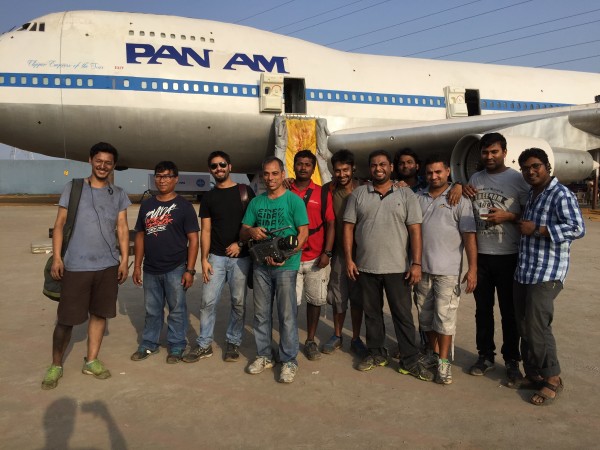
Mitesh with his team
So planning has played an important role….
Planning is the key actually. It was the biggest help. We spent so much time to figure the placement of lights, how to make them stronger and so on. I think we assembled the best crew that I could ever ask for. In this film, every single person has blended in so well that no department has overpowered the other. Each and every person was an asset to the film.
READ: EDITING IS NOT SIMPLY A CRAFT BUT UNQUESTIONABLY AN ART
What was your approach to shooting the action sequence and the climax?
It was very tricky to light that because I wanted it to look natural as the lights had gone off. And then there was a live explosion. The whole climax was also shot in one take as we wanted the bombs to go off at the right time. We didn’t want to shoot the climax separately which is the most common way. Our associate director Sandeep Modi came up with an amazing number system. Everyone knew the count at which they had to stand up, leave and when the blast was going to happen. It was well synchronized.
I got the idea about the lighting when I was on a flight from Mumbai to Delhi and suddenly the lights went off. The emergency lights then came on. So I knew how the plane had to be lit when all the lights go off. We put up spotlights all across the plane and again the actors were free to move wherever they wanted. We also had directional lights at the bottom to help people see the direction they were going in. It was really scary to shoot that because the blasts were happening just a few feet away. But no one was hurt.
When you allow the actors to freely move around, doesn’t it demand a lot from your end to capture them in the frame?
I had told the actors about the spaces where I would prefer them to be in; but at the same time I didn’t want to restrict them. Basic position wise they were more or less in the right place, but they were there with their own motivation. In fact, I can’t think of even one incident when they were not at the right place.
READ: NEERJA BHANOT WAS THE REAL INSPIRATION FOR THE MUSIC
Which camera have you used and what determined your choice of camera?
I shot with ARRI Alexa using anamorphic lenses and the reason I chose that was because we had a lot of extreme conditions in terms of highlights, shadows etc. So I needed a camera that could support all of that. I tested a couple of cameras but I was sure about shooting with Alexa.
Have you’ll employed VFX for any parts?
A lot of VFX has been used. It was done by Pankaj Khandpur from Tata Elxsi. Ram and me spent around two months in post-production looking at the VFX shots and making them so precise that they blends into the naturalness of the film. A lot of touch ups and clean ups were done in the plane shots. Also, one side of the plane (the wings) was built while the other was not. The take off of the plane was also done in VFX.
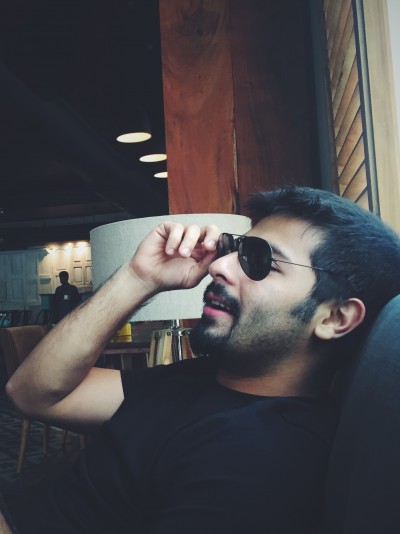
Mitesh Mirchandani
Which was the most difficult scene to shoot?
The long takes were what I was scared off but even that went really well. We were just in it because of the emotions. I was so close to the actors all the time and seeing their emotions so closely was a experience in itself.
What is the biggest compliment that you have heard for your work in Neerja?
Montu Bassi who is an art of living teacher called me and said, “I went to watch your film and see what have you done with the cinematography. But down the line I just couldn’t think about the cinematography anymore. I was so gripped in it.”
It was the best compliment for me because someone who went to notice the cinematography was so gripped that he almost forgot about it.
READ: I WANT TO GLORIFY UNSUNG HEROES THROUGH MY WRITING
Introduce us to your team for the film.
Shiv Karla was the first AC and he put in the same amount of energy as I did. He was on top of everything. Sanjeev Tamrakar was the focus puller on my camera. He is the best focus puller in the business. The other camera operators were Harshvardhan Waghdhare with focus puller Nelson Mitchell, Sudip Sengupta with focus puller Sooraj and Rohan Thakur with focus puller Kishore. Vishnu was our gaffer and Sunny Singh was the colorist.
As we sign off, tell us a bit about your background and foray into films.
Born and brought up in Mumbai I actually wanted to be a pilot. But my father said that the industry is not doing well. So cinematography was an alternate option. I worked on a small American TV series in 2008 as the production assistant. That’s when I got well acquainted with the cinematographer. Since my dad is an electronic engineer, I have been brought up with cameras all around. I love equipment and technology. I went on to study cinematography at New York Film Academy in 2010 and soon after I was back, I was offered a Marathi movie called Vakratunda Mahakaya. Right after that I got Luv Shuv Tey Chicken Khurana and post that I have been shooting commercials.

